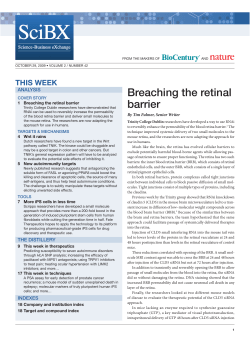
Grand Rounds
Grand Rounds PREECLAMPSIA Taylor Strange, D.O. University of Louisville Department of Ophthalmology and Visual Sciences 8/3/12 Subjective CC: “My vision is blurry and distorted” HPI: An 18 y/o AAF G1P1 presented to the ER three days after giving birth with complaints of headache, bilateral inferior limb edema and blurred vision OU. Blood pressure was 210/140 mmHg. Vision described as “shadows” that waxes and wanes. Urine analysis showed proteinuria. Lab work revealed normal platelets and LFTs. Her hypertension resolved with treatment. She followed up in the eye clinic three days after her ER visit with improved symptoms. POH: None PMH: None (no HTN or DM) Meds: Toprol, Diovan FHx: none Objective VA(sc): MRx Pupils: OD 20/25 OS 20/40 “distorted” +0.75 sph (20/20) +1.25 +0.50 x180 (20/30) 3 -> 2 3 -> 2 no APD IOP: SLE: 16 15 WNL OU Fundus Photos OD OS Bilateral yellow placoid discoloration of the RPE/choroid with exudative retinal detachments OCT OD OS Bilateral neurosensory retinal detachment in the central macula Impression 18 y/o AAF with progressive decrease in VA OU found to have bilateral exudative retinal detachments DDx: Pregnancy Induced Hypertension Central Serous Chorioretinopathy Vogt-Koyanagi-Harada Syndrome Preeclampsia Preeclampsia is an obstetric disease of unknown cause that affects approximately 5% of pregnant women. Occurs any time after 20 weeks of gestation and up to 6 weeks postpartum. Characterized by the presence of elevated blood pressure, proteinuria greater then 300mg in 24 hours and edema. Retinal detachment is a rare complication of preeclampsia, affecting less than 1% of patients with its severe form and 10% of those with eclampsia. Exudative Retinal Detachment Secondary to Pregnancy Induced Hypertension It was first described by von Graefe in 1855. Fundus Findings: Usually no retinal vascular changes Subretinal fluid Yellow-white subretinal deposits – Acute choroidal infarcts Late RPE mottling Exudative Retinal Detachment Secondary to Pregnancy Induced Hypertension Pathogenesis Hypertensive choroidopathy endogenous vasoconstrictor agents leak freely from the choriocapillaries and act on the walls of the choroidal vessels resulting in choroidal vasoconstriction and ischaemia Subsequently ischaemia of the RPE causes degradation of the outer blood-retinal barrier and formation of a serous proteinaceous exudate from the choroid, through the RPE, into the subretinal space, producing serous retinal detachment. Fluorescein Angiography FA and indocyanine green angiography indicate that many of the retinal damage displayed in preeclampsia are due to alterations of the choroidal vasculature Following the resolution of retinal detachment is an alteration in the form of irregular focal areas of hyper-and hypopigmentation, which correspond to the choriocapillaris ischemic stroke (Elschnig spots) Clinical Course Observation Return to clinic today Consider FA Treatment/Prognosis Observation Most patients have full spontaneous resolution within a few weeks without sequelae. Medical treatment with antihypertensive drugs and steroids may be helpful. Association Between Pregnancy-Induced Hypertensive Fundus Changes and Fetal Outcomes Karki P1, Malla P2 , Das H2, Uprety DK3, Department of Ophthalmology, KIST Medical College Teaching Hospital, Imadol, Lalitpur, Department of Ophthalmology, 3 Department of Gynecology and Obstetrics, B P Koirala Conclusions: Retinal and optic nerve head changes are associated with low birth weight. Choroidal changes and optic nerve head changes are associated with low Apgar score. Fundus evaluation in patients with PIH is an important procedure to predict adverse fetal outcomes. References Yannuzzi LA, The Retinal Atlas Chapter 9 (Pregnancy induced retinal changes), pages 422-429 Friedman, Kaiser, Trattler; Review of Ophthalmology pages 320-321 Yanoff, M, Duker, J; Ophthalmology 2010, page 359 Confocal Blue Reflectance Imaging in Type 2 Idiopathic Macular Telangiectasia; Peter Charles Issa, Tos T., M. Berendschot, Giovanni Staurenghi, Frank Holz, Hendrik P.N. Scholl; IOVS, March 2008, Vol 49 No. 3 Eye (2002) 16, 491–492. doi: 10.1038/sj.eye.6700056 Bilateral serous retinal detachment as a complication of HELLP syndrome P G Tranos1, S S Wickremasinghe1, K S Hundal2, P J Foster1 and J Jagger1 Thank You
© Copyright 2025





















